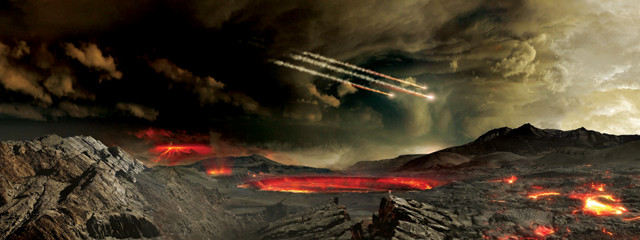
by Sarah Derouin Thursday, February 15, 2018

Frequent impacts from large meteorites during the Hadean Eon could have instigated temporary episodes of subduction and active plate tectonics on Earth. Credit: NASA's Goddard Space Flight Center Conceptual Image Lab.
Earth in the Hadean Eon, between 4.56 billion and 4 billion years ago, was much too hot to support active plate tectonics as we know it today, where cold, established plates slowly march around Earth. Yet some evidence, including from tiny zircon crystals dating to the Hadean, has suggested that a form of plate tectonics was active by about 4.1 billion years ago — about a billion years before many researchers think modern plate tectonics started. The mechanisms that could have initiated and sustained early tectonics are unclear, but according to a new study, constant bombardment of early Earth by meteorites could have triggered temporary bursts of early tectonism.
Early Earth was characterized by extended periods of what’s known as stagnant-lid tectonics, with a thin, buoyant lithospheric shell sitting motionless atop a hot mantle. In the new study, researchers simulated what would have happened when the thin-skinned, hot, ancient Earth was pummeled with meteorites of various sizes.
“No one had considered what effects impactors of different sizes might have had on the early Earth, mostly because it’s extremely hard to simulate Earth under these conditions,” says Craig O’Neill, a planetary geologist at Macquarie University in Australia and a co-author of the study, published in Nature Geoscience. “Earth was just so hot that motions [in Earth’s interior from impacts] occurred very fast and at a very small scale, making it hard to simulate,” O’Neill says.
The team used information from collections of other planetary craters and asteroid belt populations to help constrain the sizes and other details of impactors that likely hit the early Earth, ultimately simulating meteorites with radii ranging from less than 70 kilometers to more than 500 kilometers.
The researchers found that the pressure from an impact could thin the lithosphere and spur large-scale upwelling of mantle magma, which, when it reached near the surface, spread laterally. This horizontal spreading stressed the lithosphere, creating a short burst of tectonic activity lasting about 5 million to 10 million years in which portions of the lithosphere subducted into the mantle. After these episodes of subduction, a stagnant lid reformed on the surface, remaining intact until the next impact occurred.
It didn’t take a particularly large impact to kick-start the process, O’Neill says. “Sometimes the impactors were only about 70 kilometers across, but the moment they punched into the lithosphere, subduction started.” Previously, impacts like those were thought to be too small to matter in instigating tectonic activity. “We showed that in a system that is primed for tectonic activity, [small impactors] can tip it over the edge,” he says.
In a research highlight in the journal Solid Earth Sciences about early plate tectonics, Weidong Sun of the Chinese Academy of Sciences wrote that the rigidity of plates on the hot Hadean Earth is the key factor with respect to whether impacts could have initiated tectonics. Impacts, as presented in O’Neill’s study, “provide a mechanism for establishing weak points in the crust conducive to forming plates,” Sun wrote. But “under sufficiently high fluxes, [they] could destroy the plates. In this respect, impact is not the ideal trigger for plate subduction,” he wrote. Nonetheless, “the effects of moderate-scale impact cratering could [have been] significantly different in the Hadean” when conditions in the mantle were very different than today, he noted.
At the start of the project, O’Neill says the team wasn’t sure if their impact simulations would trigger tectonic activity on early Earth. “There are physical reasons why impacts might help or hinder subduction; but in the end they seemed to power [subduction] pretty effectively” in the Hadean. It’s unclear if, or for how long, the process could’ve lasted into the Archean, he says, adding that the team is concentrating on that for their next research question.
© 2008-2021. All rights reserved. Any copying, redistribution or retransmission of any of the contents of this service without the expressed written permission of the American Geosciences Institute is expressly prohibited. Click here for all copyright requests.